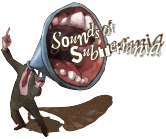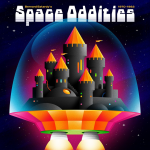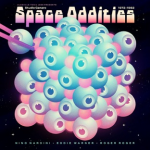Artists
Hier findet ihr die Künstler/Bands.
SPACE ODDITIES - STUDIO GANARO
- 01. Artifice Percussion
02. Cha Tatch Ka
03. Asiatic Dream
04. Pussy Ring
05. Implacable ring
06. Super Angoisse
07. Phasing Round
08. Sexy Soxy
09. Gang Train
10. Rallye Du Diable
11. Percussionnistement Votre
12. Emeute à Tokyo
13. Coeur Polaire
14. Pussy Cacatoes
15. Angoisse au Coeur
16. Marionnettes ClubSPACE ODDITIES - STUDIO GANARO
Feat BERNARD ESTARDY
- Format
- LP
- Release-Datum
- 01.03.2018
- EAN
- EAN 3521381544046
- Format
- CD
- Release-Datum
- 01.03.2018
- EAN
- EAN 3521383444030
SPACE ODDITIES - STUDIO GANARO
Feat ROGER ROGER, EDDIE WARNER & NINO NARDINI 1972-1982
[engl] During the 60s and 70s, three distinguished old gentlemen who had built their careers playing “made in France” exotic jazz – Roger Roger, Nino Nardini and Eddie Warner – met every evening in the Ganaro recording studio, playing like kids with their new toys: souped-up keyboards that looked more like prototypes of spaceships to explore the Milky Way. Flying high on whimsical and joyful inspiration, the improbable trio used their strange instruments to sketch out the beginnings of something that, at that time, resembled the future of music. Let’s take a trip with them toward a pop, light-hearted and electronic future. At the dawn of the twentieth century, Roger Roger and Georges Achille Teperino entered the world. Roger was born in 1911 in Rouen; Teperino the year after in Paris. They followed in their parents’ footsteps. Roger’s mother was a singer, and his father conducted the orchestra at the Opera. Teperino was taught music by his father, an Italian violinist and composer. Roger and Georges met in secondary school in 1927 and became the very best of friends, to the extent that Roger’s first wife was Teperino’s mother, making the latter his son-in-law. They formed a band called Les Diables Rouges (The Red Devils) that played halls and nightclubs where people would swing dance. For the band, Teperino adopted a nickname that made him famous: Nino Nardini. After World War II, he formed the Nino Nardini orchestra, specializing in “exotic” musical styles. They set the dance floors on fire in the clubs where young people, when not flirting, would twirl to the paso doble, foxtrot, calypso, slow rock, cha-cha and tango. At the same time, he conducted an orchestra for Radio Luxembourg, and one in a traveling circus, providing closely-tailored accompaniment for acrobats, clowns and lion tamers. For his part, Roger Roger (his real name) also worked as a conductor at Radio Luxembourg and accompanied Edith Piaf, Maurice Chevalier, Jean Sablon and Charles Trenet on stage. Radio France asked him to record some of his compositions as production music for its programs. These melodies attracted the attention of Chappell & Co., a music publisher in London that had just opened a department specializing in library music, which they sold “by the ton” to radio, television and cinema. Roger thus made his debut in production music. He was to become an emblematic figure in this domain, for the profusion and eclecticism of his productions, but, above all, his pronounced taste for experimentation. Nardini soon joined him in what appeared to be a new Eldorado. Together the pair made a clean break with rigid French traditions, via compositions featuring unexpected instruments like the harpsichord, marimba and Ondioline. Later, when the first analog synthesizers, oscillators and other electronic keyboards appeared, they were adopted as well. Always seeking innovative sounds, Nardini got deeply into concrete music in the early 60s, as put forward by Pierre Schaeffer (who had just founded the GRM, Groupe de recherches musicales), popularized by Pierre Henry and twisted by the whimsical Jean-Jacques Perrey. Seeking independence, Roger and Nardini decided to create their own studio in Jouy-en-Josas, southwest of Paris. They handled the creative side, while Francis Gastambie took care of the business end. The studio was named “Ganaro,” an acronym of the first two letters of their respective family names. It became the scene of magical nightly sessions of experimentation, in the company of their friend Eddie Warner. The acquisition of a Moog synthesizer brought these pioneers of electronic music to a new level. Roger Roger manufactured his own punch cards to invent new sounds. Then, in 1969, under the pseudonym of Cecil Leuter, he published the albums Pop Electronique and TVMusic 101 (with Nardini), two truly avant-garde “100% electronic” disks that anticipate the hegemony of machines in pop music, from space disco in the late 70s to the electro funk of the early 80s. With a Stakhanovite output of production music, the duo composed more than 40 albums (including the incredible Informatic 2000) for specialized labels: Chappell Music, Southern Library of Recorded Music, Neuilly, IM (Eddie and Hannelore Warner’s label, which published, notably, The Strange World of Bernard Fèvre in 77) Mondiophone, Hachette, Musax and Crea Sound Ltd. A veritable Atlantis of electronic music, rediscovered at the turn of the 21st century by electronic artists like Barry 7 of Add N to (X), with his Connectors series, or Luke Vibert, with the Nuggets compilation. Jess and Alexis Le Tan contributed a bit as well, digging up a few gems from “Ganaro’s Nights,” tracks composed with joy and humility by a merry trio of sixty-somethings for whom making music was always a source of amusement and wonder. Nino Nardini passed on in 1994; Roger Roger in 1995. Eddie Warner (the fortunate composer of the theme song for the TV game show “Des chiffres et des lettres”) had died a few years earlier.- Format
- LP
- Release-Datum
- 19.04.2016
- EAN
- EAN 3521381535976
- Format
- CD
- Release-Datum
- 19.04.2016
- EAN
- EAN 3521383435960


